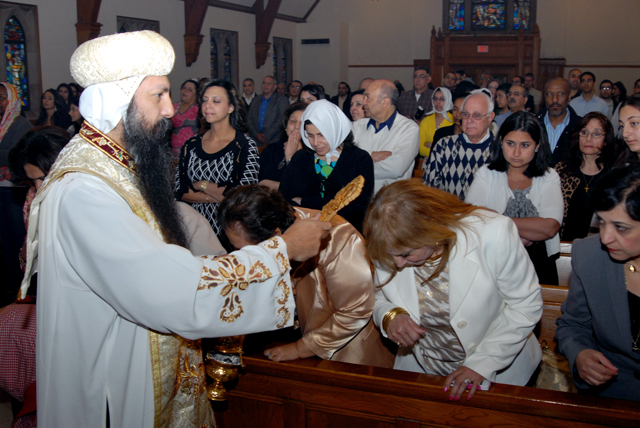Egyptian Coptic Church Grows in U.S.

St. Timothy & St. Athanasius Coptic Orthodox Church began services on April 28 in Arlington Va., as the first Coptic church to use English predominantly as opposed to the traditional mix of Arabic and Coptic language. Photo courtesy of St. Timothy & St. Athanasius Coptic Orthodox Church.
By Jordan Humphreys
For Reporting Texas
The day after most Americans celebrated Easter, Andrew Ishak was still planning his family’s Easter feast the next Sunday in California. He talked to his brother on the phone about incorporating fried chicken into as many dishes as possible after 55 days of vegan fasting.
Ishak is Coptic, a member of a Christian Orthodox religion based in Egypt. The Coptic faith is a form of Christianity steeped in cultural influences from the Mediterranean and Egypt. Services are traditionally in Arabic and Coptic, the dead language attached to the religion.
“The cultures are so interwoven in Egypt,” Ishak said. “The things that we eat are influenced by Muslim customs in Egypt, and we influence them.” For instance, pork is never a main dish in Coptic food because it is forbidden in Islam and difficult to find in Egypt.
Coptic churches in the United States are growing, as second-generation Americans follow their parents in the faith. But also fueling the growth is strife in Egypt, where the Coptic minority was violently persecuted after the Arab Spring.
Ishak, a doctoral candidate in communication studies at The University of Texas at Austin who is from Cupertino, Calif., said that initially he had been excited during the Arab Spring movement because the Egyptian people were fighting against an oppressive government. But soon he and the rest of the world realized that the revolution in Egypt was playing out differently for 10 million Copts, who were victims of mob attacks and church burnings. Last year, 42,000 Copts of the 100,000 who left Egypt after President Hosni Mubarak’s resignation came to the United States. In all, about 378,000 Coptics live in the United States, or 71 percent of the worshipers outside of Egypt.
Chris Estafanous, a Coptic deacon who lives in Virginia and grew up in New York, says New York is always the first stop for new Coptic immigrants. He said the area’s churches have been seeing an influx of asylum seekers since Tahrir Square became the object of media fixation.
“New York and New Jersey have people flooding into the area,” he said. “St. George in Jersey City gets 10 new families a day because of religious asylum,” causing church leaders to open satellite branches to serve new members.
Ishak says Coptic culture has been so well preserved in the U.S. because immigrants would often live close to each other in tight-knit communities isolated within just a few major cities. “As we go across the country, we don’t worry as much about who we identify with,” he said.
Monica Attia grew up attending Saint Mark Coptic Orthodox Church in Bellaire, near Houston, one of the first Coptic Orthodox churches built in the United States when it was completed in 1977. It currently has more than 200 families.
Attia, who learned to read and sing in Coptic as a child, said that she appreciates unique rituals like the 10-hour Good Friday service with first-century Coptic-language hymns.
“I grew up going to hymns class, learning the language and building up to a 12-minute hymn only sung on Good Friday,” said Attia, who now attends church in Round Rock, the only Coptic church in the Austin area. “It’s so amazing to be able to participate. It adds so much depth to my faith.”
As second-generation Coptic Americans like Estafanous, Attia and Ishak start families of their own, many are wondering how much of their religion’s rituals and symbolism will remain.
“I have a 3-year-old daughter,” Ishak said. “And I’m interested to see how Coptic and how Egyptian she’s going to feel 25 years from now.”
Ishak, who is married to a non-Egyptian, speaks poor Arabic and has never lived in Egypt, says he sees himself as less Egyptian, and he wonders how the disconnect will affect his daughter’s concept of religion and Christianity.
As Coptic churches spring up across North America — from two when the late Coptic Pope Shenouda III was appointed 40 years ago to more than 200 today — some Copts say the religion and Egyptian culture need not be so linked.
The newest church, St. Timothy & St. Athanasius, had its first service on April 28 in Arlington, Va. Under Father Anthony Messeh, the first American-born Coptic priest, the service skipped Coptic and Arabic for an all-English liturgy. Estafanous, a deacon at the new church who is helping create English-language catechism classes, says this is a way for the church to preach its message without getting lost in Egyptian culture.
“This is a Coptic church catering to Americans who feel that Arabic culture is a barrier to worshiping God — this church eliminates all of those cultural barriers,” Estafanous said, adding that removing the barriers of language and culture won’t take away from the church’s message.
Ishak, reflecting on the more than 10 million Copts in Egypt, said he wondered how the Arab Spring would disperse the religious minority. “I really wonder, in 30 years, will we have more Copts in Egypt or outside?”
Estafanous said that he thinks all Coptic churches in America are going to look like the Virginia church in that time span.
“The Coptic Church will always maintain its rites and traditions, but now it will wear a modern garb to fit the people it serves,” he said. “In the next 30 years, there’ll be a need for our presence in America to be American.”